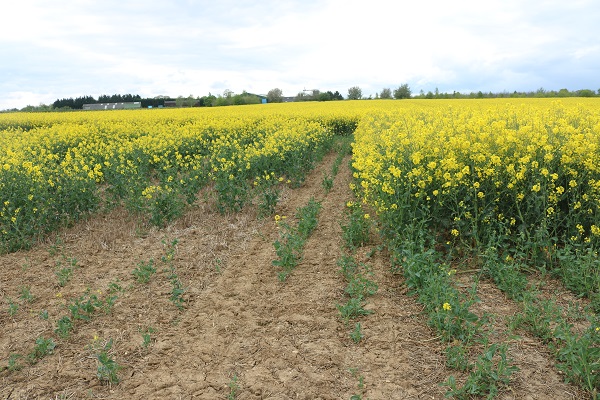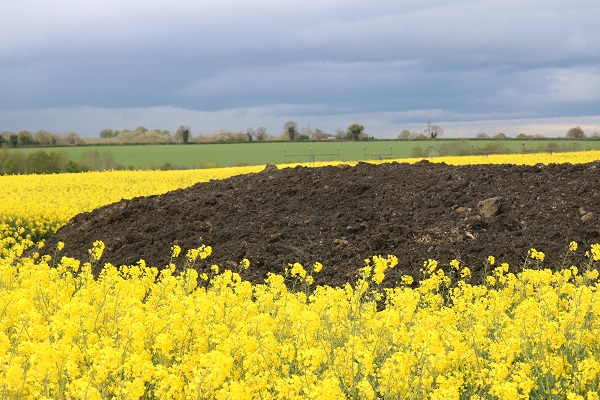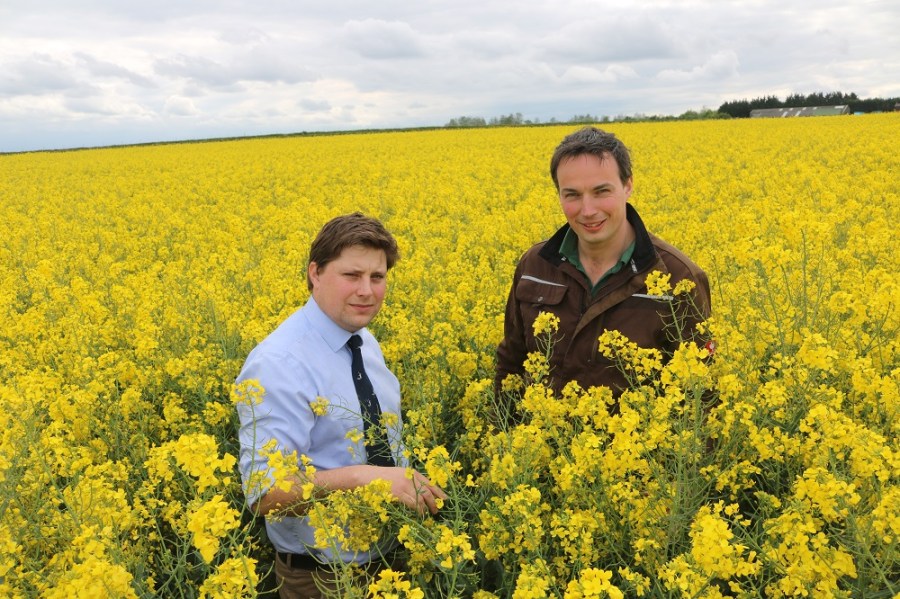Oxon grower James Price has tailored his oilseed rape strategy to make the most from the thin, brashy soils they sit on. CPM pays him a visit.
On this brash, there’s no depth, and we run out of moisture very easily.
By Tom Allen-Stevens
While there are plenty of oilseed rape crops across the UK currently pock-marked with patches or bristling and wavy with an uncertain canopy, you’re greeted by a uniform sea of yellow at Perdiswell Farm, near Woodstock, Oxon. In fact, the one flaw that lets down this otherwise perfect panorama is the area of late-drilled OSR in the 3×3 trial plot that sits within it.
Compact canopy
“It’s DK Exalte and I’m quite pleased with it,” comments James Price, pre-empting the question. “It’s a very neat, compact canopy, and an even yellow with some nice, thick branching. The crop looks good, so this is probably a variety we’ll stick with.”
The 10ha crop of Exalte joins another 30ha of Incentive on the 650ha of Cotswold brash with some heavier clay he farms. The hybrid varieties are balanced with an equal area grown to open-pollinating types, with Campus being the choice this year.

The 3×3 plots at Perdiswell Farm demonstrated the variability of establishment with many OSR crops this year.
“We’ll normally try one new variety each year and that gives us a comparison. If the new hybrid outperforms the old one, we’ll swap it out. The hybrids are good because you get the vigour. But I like the conventional varieties, too, as we farm-save seed. These we’ll usually keep for about three years before looking to change.”
A keen interest in OSR has always meant James Price has given the crop a fair bit of attention. But in recent years he’s benefited from the practices under scrutiny in the 3×3 trials he hosts, putting some of these to good effect to hone his own system.
One that’s been working well is applying seedbed fertiliser, he says. “The problem with establishing OSR is that you’re turning round acres at a very busy time of year, and we’re tight on labour.”

The rows to the left in on-farm, field-scale trials of the system demonstrate a clear advantage for the crop that received seedbed fertiliser.
This prompted him to move to the Claydon one-pass system he now uses to establish the OSR, while a Väderstad Rapid is the drill he depends on to get the other crops in the ground – wheat, spring barley and winter or spring beans in a five-year rotation.
Despite the constraints on time, he was keen to do everything he could to get the crop established well, so the drill was adapted with liquid fertiliser passed down the leading tine, pumped from an 800-litre front-mounted tank.
“We put on only 100 l/ha of 16:16:0, but because we’re band-applying it, we could be treating as little as an eighth of the area. That means there’s a very concentrated band placed just under the seed, and you notice when the roots hit it – the growth just takes off.”

The farm’s thin soils are fed around 6-7000t/yr of manures and organic wastes to help bring a more consistent yield.
His own on-farm field-scale trials of the system he carried out for the first two years demonstrated an “unbelievable” difference, he says. But the greater challenge he faces is the soils themselves. “On this brash, there’s no depth, and we run out of moisture very easily. That means a good average yield is 4.0t/ha, which we like to maintain.”
Thin soils
The thin soils are given plenty of assistance, however, in the form of a variety of manures and organic wastes he brings onto an on old airfield on the farm to be mixed, sorted and strategically placed around the rotation. “We get through about 6-7000t of material every year, including compost, biosolids, clean-water sludge and farmyard manure, swapped for barley straw,” explains James Price.
“Logistics tend to dictate what goes where, but I try to get biosolids in front of the spring barley (grown for seed) and after the OSR, while compost works well in front of OSR.” As a result, he’s not had to apply any artificial P and K for 10 years on his brash, and recent soil-sampling confirms indices are good.
The OSR crop follows spring barley, or some of the wheat if there’s a larger area, and timing is key, reckons James Price. “We aim to drill in mid Aug and be done by the end of the month. Ideally you want to catch the conditions just right to get a good establishment.”
He drills at the relatively high seed rate of 50 seeds/m², for both hybrid and conventional varieties, but pares this down to 30-40 seeds/m² if conditions are “growy”, aiming for a plant count in the spring of 30 plants/m². “I’m know we’re going too thick, but this soil is unpredictable – I’d rather have a crop we manage backwards than tease one out of a thin plant stand.”
Whether it’s thick or thin, he leaves determination of nitrogen rate largely in the hands of technology. He uses an N-Sensor set to apply fertiliser on its Absolute N setting, which scans the crop and decides for itself how much nitrogen it needs.
“We’ve been using it since 2008. We put it to the test in two tramlines – one side received our farm-calculated rate of 180kgN/ha and the other, determined by the N-Sensor, received just 100kgN/ha. There was no yield difference, so you look at that and say, ‘wow!’”
The farm has been on liquid fertiliser since 2009, applied through a Berthoud Major 32, with the OSR receiving N25 + 14.3SO3, and cereals starting on N19+19SO3. He leaves the N-Sensor to do its thing on those parts of the OSR crop with the greatest yield potential, and this’ll apply two top dressings.
“The aim is to get on as soon as we can in mid Feb,” says James Price. “I prefer to go little and often, applying three dressings where I determine the rate, which is done with the help of the ImageIT app. I’m not sure my rate would be better than the N-Sensor, but I’m not brave enough to let it do the whole farm, and it’s useful to have a comparison.”
So up to two dressings will be made at the beginning and end of March. “We’ll then decide whether to top up with 30kgN/ha applied as Nufol at mid-to-late flowering. If it stays dry this year, I think the crop will need it. But if we get some rain, it’ll take up the N from the soil.”
Helping him keep the crop healthy is Farmacy agronomist Ed Brooks. “In the autumn, we’d only spray for phoma if the 10% of infected leaves threshold is reached. The varieties currently grown are pretty good on phoma, and it was a low disease autumn, so you could get away without anything. But light leaf spot changes all of that. You have to protect the crop, and the Nov/Dec timing was best for that this year.”
In the spring, crop growth determines the early fungicide, he continues. “Where there’s a low GAI, we go with prothioconazole plus tebuconazole. But forward crops, like the Exalte this year, get 0.75 l/ha of Caryx (mepiquat chloride+ metconazole) with the tebuconazole. It’s needed for late lodging and to improve light interception. Caryx is the only true PGR in OSR – by the time you get to stem extension, metconazole alone simply isn’t enough.”
The aim is to apply just one sclerotinia spray at full flowering, with Pictor (boscalid+ pyraclostrobin) being the product of choice. “It has to go on before petal fall to protect the crop, although in 19 out of 20 years sclerotinia isn’t a problem.
“What Pictor’s good for is the greening. On this brash, the crop burns out very early on. It can delay senescence by three days, which at that time of year can make all the difference to pod fill.”
Brassitrel Pro is also applied in the spring, adds Ed Brooks. “It’s relatively low cost and gives the crop the four essential elements it needs – boron, molybdenum, manganese and magnesium.”
As harvest approaches, a pod sealant is usually applied with the desiccant. “It’s an insurance against a late storm. It’s best to apply the pod sealant two weeks before the desiccant, but the Exalte has pod-shatter resistance, which offers more protection. I’d still want to apply a pod sealant, but it’s not so important to put it on as an early application,” he concludes.




